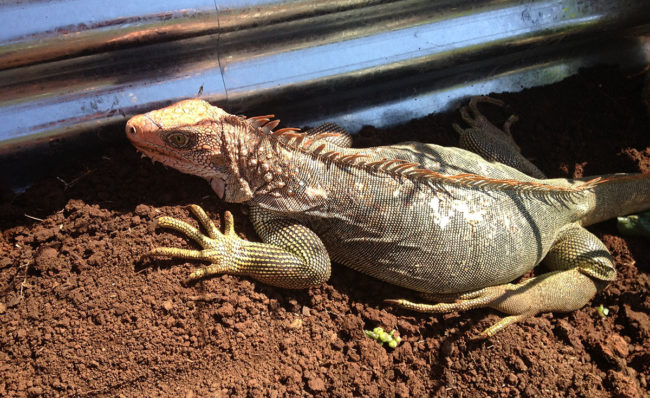Animal Challenges
A tropical organic farm is a giant salad bar to wild animals
I love jungle animals. Birds, bugs, bats, and beasts of all types. When I first moved to Costa Rica in 2004 I took the time to learn the life habits of every mammal in our jungles, and the names of every bird too. Now, trying to run an organic farm that’s surrounded by wild animals, I feel like shooting a shotgun at any critter that moves. Why? Because after three years of solving the problems of seed varieties, fungus, soil dynamics, bugs, and diseases, when we finally get things growing well, every living thing in the forest comes to eat it!
My friend Terri Zacanti, who also has a small farm here told me she planted food for the wild animals along the fringes of their gardens, hoping that the animals would eat it and stay in their feeding zones. But alas, they often prefer to walk right through that food and go straight into her garden beds. She correctly pointed out that by planting more food for them, they multiply, and attack her farm in ever greater numbers. She also planted trees to connect a new wildlife corridor across her land, and the animals use that to more easily access her crops.
In permaculture design, a sustainable farm has wild zones that are useful for native medicinal plants, wood, mulch, habitat for helpful birds, bugs and animals, etc, but it also brings dozens of varieties of ravenous and relentless furry pests that raid nearly everything we grow.
So what solutions are there? In the “good old days” the solution was simple and easy: kill them! Guns, bow and arrows, slingshots, and poisons were used to eliminate any threat to a farmers crops. These days, that solution is not only illegal in Costa Rica, but goes against the grain of most people who are trying to live a permaculture lifestyle. The question remains, however, whether it’s realistically possible to maintain a sustainable tropical farm while living in harmony with jungle animals.
Solutions to Animal and Bird Problems
Here are a few solutions we are trying here at Rancho Delicioso:
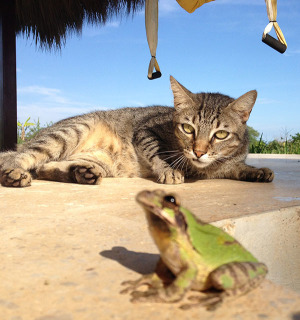 Cats: – Cats are very good to keep away rats. Even if they’re too lazy to catch them, their scent and urine supposedly deters rats. It occurred to me to train our cat to use a cat box filled with sand, and then distribute the sand around areas where you don’t want rats. But this, like so many ideas, is very labor intensive and there aren’t so many hours in the day for this type of solution.
Cats: – Cats are very good to keep away rats. Even if they’re too lazy to catch them, their scent and urine supposedly deters rats. It occurred to me to train our cat to use a cat box filled with sand, and then distribute the sand around areas where you don’t want rats. But this, like so many ideas, is very labor intensive and there aren’t so many hours in the day for this type of solution.
Dogs: – A large dog is good for a farm, but requires training to keep it from chewing on stuff, trampling seedlings and garden beds, or growling at our guests. We currently have a boxer puppy who will grow to 80-90 pounds. We will train him to chase away any jungle mammals like deer, coyotes, peccary, raccoons, coatis and foxes.
Electric Fence: – An electric fence can keep large mammals away from your goats and chickens, while keeping goats confined to a particular grazing area. But they inevitably break, or the power goes out, or animals figure out how to jump over or crawl under them. Like so many other things, this takes work and maintenance, with a lot of trial-and-error.
Nets: – A visiting permaculture expert from Australia told me that in the tropical regions of her country Queensland/Cairns, those who choose to do permaculture assume that they are going to cover all their growing areas with thin, inexpensive nets/screens that keep out these animals and birds. Unfortunately, nothing like that is sold in Costa Rica that I’ve seen.
Overproduction: – The first two times we planted corn, the raccoons, rats, and bluejays ate almost all of it. On our third crop, we decided to try planting 10,000m2 of corn, hoping that if we produce a huge quantity they can’t possibly eat it all. It may backfire though because maybe they’ll just multiply or bring their friends, and then we’ll have even more of them to deal with.
 Scarecrows: – We made our first scarecrow to keep away birds who were eating the corn. It doesn’t seem to work. One good trick however is supposedly to put a pair of sunglasses on both sides of its head, which will apparently give it a 360 degree effectiveness, since many birds are smart enough to sneak up behind a scarecrow.
Scarecrows: – We made our first scarecrow to keep away birds who were eating the corn. It doesn’t seem to work. One good trick however is supposedly to put a pair of sunglasses on both sides of its head, which will apparently give it a 360 degree effectiveness, since many birds are smart enough to sneak up behind a scarecrow.
Stone Throwing: – For animals like coatis and raccoons, who come in families, we chase them, yelling, clapping, and throwing rocks and sticks. We can shoot slingshots at them too, with the idea to scare them into understanding that they’re not welcome in OUR territory. They can stay in the jungle where they belong.
Traps: – We have some live traps, such as from Havahart, for catching smaller creatures like mice and rats, but generally they don’t work well.
Walls: – In some areas we’ve made tin walls that surround garden beds and keep out rats and iguanas. They help with grasshoppers too. However, the animals often find a way to burrow under or find a weakness such as a gap or corner between panels, or an edge they can get a grip on to climb over.
Crazy Ideas that Just Might Work
They say that desperation is the mother of invention, and living on a farm you get plenty of time to stare into space and think up devious ideas for how to deal with our animal terrorist friends who defy all attempts to keep them out. So, these are a few things I have yet to try:
-
Fake Predators – Perhaps it would work to get some of those fake owls and putting them around the farm on various branches, to keep away bluejays or other birds that might be afraid of them.
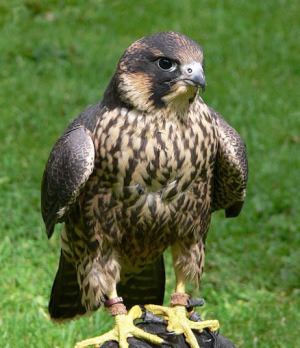 Falconry – Wouldn’t it be cool to have your own eagle or falcon who you could command to pluck rats off your corn stocks and bluejays from your mulberries? Shooting bluejays doesn’t seem very PC but I think I’d be okay with feeding them to a pet falcon. However, I imagine the learning curve and expense of getting into a rare hobby like falconry wouldn’t really be worth it.
Falconry – Wouldn’t it be cool to have your own eagle or falcon who you could command to pluck rats off your corn stocks and bluejays from your mulberries? Shooting bluejays doesn’t seem very PC but I think I’d be okay with feeding them to a pet falcon. However, I imagine the learning curve and expense of getting into a rare hobby like falconry wouldn’t really be worth it.
Pee Party – This is the best idea ever. One of our volunteers told me that some animals such as coyotes don’t like the smell of human urine, and will respect urine-marked boundaries (see the great movie “Never Cry Wolf.”) So my idea is to lure a group of friends to the farm with the promise of free beer, with the caveat that they must pee in pre-designated areas to help us mark our territory as a no-animal zone. Not sure if it will work, but it sounds like a fun plan to try.
Snake and Tarantula Habitats – I have already tried catching tarantulas around the areas and letting them free on the farm, but we never saw them again. So version two of that idea would be to build habitats for them to live in the farm, so they’ll have safe homes and stick around to help us. Tarantulas need deep holes and crevasses to burrow into. Snakes like rock piles or perhaps we could plant banyan trees and banzaii them so they don’t get too big. A banzaii tree the size of an upturned van could house a lot of snakes. Snakes eat mice, rats, cockroaches, lizards, and other pests. Banyan trees can also house bats, which eat mosquitos and other insects at night, and their guano is the world’s best natural high-nitrogen fertilizer.
Ultrasonic Frequency Devices – You may have heard of ultrasonic devices that supposedly drive away rats and other pests. Apparently despite many dozens of varieties and companies making these things, there has never been any conclusive proof of them working as advertised. See this article: http://buginfo.com/article.cfm?id=58
List of Jungle Animals Bad for Tropical Farmers
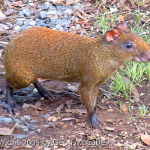 Agoutis – Veggies and Greens – Agoutis are rodents that look like a rabbit with small ears. They run around solo or in pairs, and will chew on almost any type of plants you have growing. They are really annoying in that they will often take a single bit our of something like a pineapple and just leave it to rot on the ground after knocking it off its mother plant. Unlike rabbits, they won’t multiply into large groups, but one or two can do a lot of damage. Having a dog around to chase them is probably the easiest way to handle them.
Agoutis – Veggies and Greens – Agoutis are rodents that look like a rabbit with small ears. They run around solo or in pairs, and will chew on almost any type of plants you have growing. They are really annoying in that they will often take a single bit our of something like a pineapple and just leave it to rot on the ground after knocking it off its mother plant. Unlike rabbits, they won’t multiply into large groups, but one or two can do a lot of damage. Having a dog around to chase them is probably the easiest way to handle them.
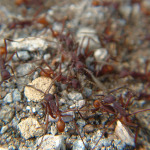 Army Ants – Bees – Army ants ravage through the jungle and generally aren’t too bothersome to humans. They can actually be very helpful by cleaning your house of scorpions and cockroaches. However, they will destroy any bee hive they find, both artificial and natural, and bees are very important for pollination. And, if you’re trying to grow predatory wasps, they will kill those too. After our first bee hive was destroyed recently, the next one we need to put with a moat of running water around it to keep the army ants off. Yet another expense and thing to have to take care of.
Army Ants – Bees – Army ants ravage through the jungle and generally aren’t too bothersome to humans. They can actually be very helpful by cleaning your house of scorpions and cockroaches. However, they will destroy any bee hive they find, both artificial and natural, and bees are very important for pollination. And, if you’re trying to grow predatory wasps, they will kill those too. After our first bee hive was destroyed recently, the next one we need to put with a moat of running water around it to keep the army ants off. Yet another expense and thing to have to take care of.
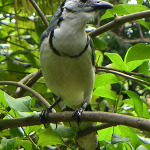 Bluejays – Corn, Mulberries – These beautiful blue noisy birds, called the “white throated magpie jay” are a major nuisance nearly everywhere they go. They are ridiculously intelligent and fearless. I’ve been attacked by them while eating lunch in Montezuma, where they swoop down to scratch your head with their claws if you annoy them by not giving them your french fries or whatever else they want. Here, they eat our corn before we can harvest it, and they go after our mulberries. One of our workers just told us he killed one with a slingshot and mounted it on a stick to keep the rest of his friends away from our mulberries (he did NOT have permission to do this I should add) but it didn’t work anyway. We have a small orchard of 20 or so mulberry trees and like many intelligent animals, these bluejays discovered it and now come back in every larger numbers, so we get few of our berries for ourselves. Solution: a visitor to the farm suggested using sparkling “red mylar flash tape” that scares away birds (they think it’s fire.) A link to where to buy it: http://www.gemplers.com/product/R40703/Bird-Scare-Flash-Tape-Red-Silver-1-x-290 Some of the local Ticos use old cassette or VHS tape in the same way.
Bluejays – Corn, Mulberries – These beautiful blue noisy birds, called the “white throated magpie jay” are a major nuisance nearly everywhere they go. They are ridiculously intelligent and fearless. I’ve been attacked by them while eating lunch in Montezuma, where they swoop down to scratch your head with their claws if you annoy them by not giving them your french fries or whatever else they want. Here, they eat our corn before we can harvest it, and they go after our mulberries. One of our workers just told us he killed one with a slingshot and mounted it on a stick to keep the rest of his friends away from our mulberries (he did NOT have permission to do this I should add) but it didn’t work anyway. We have a small orchard of 20 or so mulberry trees and like many intelligent animals, these bluejays discovered it and now come back in every larger numbers, so we get few of our berries for ourselves. Solution: a visitor to the farm suggested using sparkling “red mylar flash tape” that scares away birds (they think it’s fire.) A link to where to buy it: http://www.gemplers.com/product/R40703/Bird-Scare-Flash-Tape-Red-Silver-1-x-290 Some of the local Ticos use old cassette or VHS tape in the same way.
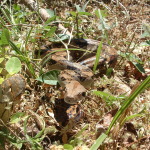 Boa Constrictors – Tilapia, Chickens – Boas are a beautiful snake that could be an ally on the farm if they stuck to eating rats. However, they are powerful swimmers and will get into your fish ponds to eat your tilapia. They also are relentless in breaking into chicken coops and will eat one if they can get in, and will return for more later. They are not poisonous, but can grow to a large enough size that they can eat cats, dogs, and baby goats. Theoretically they could grow large enough to eat bigger animals, but I haven’t heard of that happening in Costa rica. The best way to deal with them is to catch them (if you have a lot of them then buy a snake catching stick) and release them far away from your farm next to a big nature reserve.
Boa Constrictors – Tilapia, Chickens – Boas are a beautiful snake that could be an ally on the farm if they stuck to eating rats. However, they are powerful swimmers and will get into your fish ponds to eat your tilapia. They also are relentless in breaking into chicken coops and will eat one if they can get in, and will return for more later. They are not poisonous, but can grow to a large enough size that they can eat cats, dogs, and baby goats. Theoretically they could grow large enough to eat bigger animals, but I haven’t heard of that happening in Costa rica. The best way to deal with them is to catch them (if you have a lot of them then buy a snake catching stick) and release them far away from your farm next to a big nature reserve.
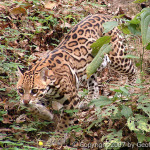 Cats – Chickens – There are 6 types of wild cats that live in the Montezuma area, and they come in all sizes from smaller than house cats to 200-pound jaguars. You’re unlikely to ever see them, but people have had trouble with some of the medium sized ones, such as a jaguarundi or ocelot, getting their chickens. Another menace is feral house cats who terrorize your own cat, or come into your house at night through an open window and pee on things or eat your food. We have had problems with one who attacks bags of bread of we accidentally leave it out.
Cats – Chickens – There are 6 types of wild cats that live in the Montezuma area, and they come in all sizes from smaller than house cats to 200-pound jaguars. You’re unlikely to ever see them, but people have had trouble with some of the medium sized ones, such as a jaguarundi or ocelot, getting their chickens. Another menace is feral house cats who terrorize your own cat, or come into your house at night through an open window and pee on things or eat your food. We have had problems with one who attacks bags of bread of we accidentally leave it out.
 Coatis – Eggs, Garden Beds – The Coatimundi, known here as pizotes, are probably the worst animal that comes to the farm. They are beautiful animals that are closely related to raccoons, and they will go after chicken eggs during the day or night. However, the biggest problem with them is that they will go to your garden bed and uproot all your plants, digging for grubs and roots. They love soft mulched beds, and will eat your carefully-grown and distributed earthworms. The males come by themselves, or family groups of 20-30 females and young visit and can do a lot of damage. A big dog can chase them off, and it’s a good idea to chase and attack them like crazy to keep them away before they discover the tender morsels in your farm. Be careful, they have very strong, sharp claws and can do a lot of damage to your dog if cornered.
Coatis – Eggs, Garden Beds – The Coatimundi, known here as pizotes, are probably the worst animal that comes to the farm. They are beautiful animals that are closely related to raccoons, and they will go after chicken eggs during the day or night. However, the biggest problem with them is that they will go to your garden bed and uproot all your plants, digging for grubs and roots. They love soft mulched beds, and will eat your carefully-grown and distributed earthworms. The males come by themselves, or family groups of 20-30 females and young visit and can do a lot of damage. A big dog can chase them off, and it’s a good idea to chase and attack them like crazy to keep them away before they discover the tender morsels in your farm. Be careful, they have very strong, sharp claws and can do a lot of damage to your dog if cornered.
 Coyotes – Chickens, Cats, Small Dogs, Baby Goats – Coyotes are large wild dogs that are extremely intelligent. They are meat eaters who will kill your chickens at night or during the day. They kill cats, and they are cannibals who will eat dogs too. I know someone who saw a coyote carry away her pet chihuahua in another area of Montezuma. A coyote once grabbed one of our baby goats and tried to carry it away, but was scared off by one of our workers (the goat was unharmed.) During the day, coyotes are known to send a female in heat to lure larger farm dogs away from the safety of a farm, and then they will kill them in a group (this was done to my australian shepherd when i was a kid living in California… he luckily escaped but had over 60 stitches from his wounds.) Coyotes are most likely to attack as the light starts going down at 4:30PM or so, or in the early morning. This is their main window of opportunity to grab some free meat off your farm before your animals are put away for the night. Killing coyotes just makes them multiply. If a pack loses too many members, then every female in the group will get pregnant, rather than only the alpha female. Most coyotes in this area were killed off from two dog-borne diseases: canine distemper and ericulosis, but have started coming back to the area and we hear them sometimes, howling at night not too far off. In many parts of the U.S. there’s a bounty on them, which doesn’t eliminate them, but keeps their numbers down to a manageable level.
Coyotes – Chickens, Cats, Small Dogs, Baby Goats – Coyotes are large wild dogs that are extremely intelligent. They are meat eaters who will kill your chickens at night or during the day. They kill cats, and they are cannibals who will eat dogs too. I know someone who saw a coyote carry away her pet chihuahua in another area of Montezuma. A coyote once grabbed one of our baby goats and tried to carry it away, but was scared off by one of our workers (the goat was unharmed.) During the day, coyotes are known to send a female in heat to lure larger farm dogs away from the safety of a farm, and then they will kill them in a group (this was done to my australian shepherd when i was a kid living in California… he luckily escaped but had over 60 stitches from his wounds.) Coyotes are most likely to attack as the light starts going down at 4:30PM or so, or in the early morning. This is their main window of opportunity to grab some free meat off your farm before your animals are put away for the night. Killing coyotes just makes them multiply. If a pack loses too many members, then every female in the group will get pregnant, rather than only the alpha female. Most coyotes in this area were killed off from two dog-borne diseases: canine distemper and ericulosis, but have started coming back to the area and we hear them sometimes, howling at night not too far off. In many parts of the U.S. there’s a bounty on them, which doesn’t eliminate them, but keeps their numbers down to a manageable level.
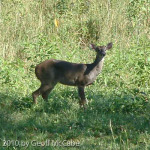 Deer – Vegetables, Greens – Bambi is very cute in the jungle, but not cute at all when it’s just eaten an entire bed of just-transplanted vegetable seedlings of some kind. Rancho Delicioso borders a very large natural area of perhaps 800 Hectares or more, that goes all the way down to the Montezuma Falls river valley, and there are plenty of deer here, despite the illegal hunting that goes on. They come to the farm to eat our sweet potato vines and other seedlings from our garden beds. They are a major pest and we are going to train our dog to chase them away.
Deer – Vegetables, Greens – Bambi is very cute in the jungle, but not cute at all when it’s just eaten an entire bed of just-transplanted vegetable seedlings of some kind. Rancho Delicioso borders a very large natural area of perhaps 800 Hectares or more, that goes all the way down to the Montezuma Falls river valley, and there are plenty of deer here, despite the illegal hunting that goes on. They come to the farm to eat our sweet potato vines and other seedlings from our garden beds. They are a major pest and we are going to train our dog to chase them away.
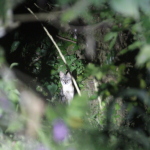 Foxes – Chickens – Foxes can climb fences and trees extremely well, and are adept at finding weak spots in a hen-house. Once inside, they will kill up to a dozen of your chickens, often tearing their heads off in a blood-lust frenzy. After the carnage, they will drag one away to eat and leave the rest for you to find in the morning. The best solution is to make sure your chicken coop is really secure so they can’t bust in. We also put out a light bulb that we turn on each night at the chicken house. It doesn’t bother the hens, but keeps away foxes and perhaps other night predators such as the many wild cat species. But, sometimes the light burns out, or someone forgets to turn it on, or the power goes out, or they get hungry enough they’ll come at night. We seem to lose a group of chickens 2-3 times per year to foxes no matter what we do. We’re hoping that our dog will learn to hear or smell them and keep them away.
Foxes – Chickens – Foxes can climb fences and trees extremely well, and are adept at finding weak spots in a hen-house. Once inside, they will kill up to a dozen of your chickens, often tearing their heads off in a blood-lust frenzy. After the carnage, they will drag one away to eat and leave the rest for you to find in the morning. The best solution is to make sure your chicken coop is really secure so they can’t bust in. We also put out a light bulb that we turn on each night at the chicken house. It doesn’t bother the hens, but keeps away foxes and perhaps other night predators such as the many wild cat species. But, sometimes the light burns out, or someone forgets to turn it on, or the power goes out, or they get hungry enough they’ll come at night. We seem to lose a group of chickens 2-3 times per year to foxes no matter what we do. We’re hoping that our dog will learn to hear or smell them and keep them away.
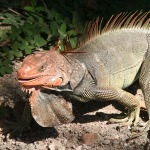 Iguanas – Greens, veggies – There are two types of very large lizards that are common in the jungle here. The photo on the right shows the green iguana, which grows up to six feet long and is vegetarian. The second is the cnetosaur, which is a bit smaller, but more common and eats just about anything. They are sometimes called gallina de arbol, or “tree chickens”, because they taste like chicken. So now you know what to do with them if they attack your farm. The other option is to put some type of slippery wall that they can’t climb around your garden beds. Don’t try to use any type of grid or mesh because they are smarter than they look and they’ll just climb over it. Corrugated tin does the trick, but is very expensive for large areas. A dog can chase them away if you have one.
Iguanas – Greens, veggies – There are two types of very large lizards that are common in the jungle here. The photo on the right shows the green iguana, which grows up to six feet long and is vegetarian. The second is the cnetosaur, which is a bit smaller, but more common and eats just about anything. They are sometimes called gallina de arbol, or “tree chickens”, because they taste like chicken. So now you know what to do with them if they attack your farm. The other option is to put some type of slippery wall that they can’t climb around your garden beds. Don’t try to use any type of grid or mesh because they are smarter than they look and they’ll just climb over it. Corrugated tin does the trick, but is very expensive for large areas. A dog can chase them away if you have one.
 Kingfishers – Tilapia – Kingfishers are an incredibly beautiful bird that’s an expert at fishing. They can and will kill tilapia fish. The solution many tilapia farmers use is to cover their ponds with metal grid that these birds can’t get through. There are more than one size of kingfisher, I haven’t ever personally seen a kingfisher kill one of our fish, but the potential is there. The kingfisher shown here in the photo hit a glass window in my house and I picked it up to keep our cat from getting it. It recovered and flew away after 3-4 minutes.
Kingfishers – Tilapia – Kingfishers are an incredibly beautiful bird that’s an expert at fishing. They can and will kill tilapia fish. The solution many tilapia farmers use is to cover their ponds with metal grid that these birds can’t get through. There are more than one size of kingfisher, I haven’t ever personally seen a kingfisher kill one of our fish, but the potential is there. The kingfisher shown here in the photo hit a glass window in my house and I picked it up to keep our cat from getting it. It recovered and flew away after 3-4 minutes.
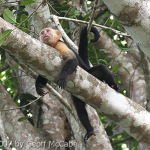 Monkeys – Corn, fruit, animal feed – Monkeys are cute, right? The howler monkeys might be because they don’t cause trouble, but the white-faced capuchin monkey is common here and one of the world’s most intelligent species. They are aggressive and will fight with (and sometimes can kill) pets. They have thumbed hands and can open things to get into your chicken feed or goat food. They eat corn and fruit. They particularly delight in taunting you by taking a single bite from each and every fruit on a tree, and hurling each to the ground in apparent disgust. They are a menace worse than those in the Wizard of Oz. Solution? Perhaps throw sticks at them and hope they don’t throw their poo back at you.
Monkeys – Corn, fruit, animal feed – Monkeys are cute, right? The howler monkeys might be because they don’t cause trouble, but the white-faced capuchin monkey is common here and one of the world’s most intelligent species. They are aggressive and will fight with (and sometimes can kill) pets. They have thumbed hands and can open things to get into your chicken feed or goat food. They eat corn and fruit. They particularly delight in taunting you by taking a single bite from each and every fruit on a tree, and hurling each to the ground in apparent disgust. They are a menace worse than those in the Wizard of Oz. Solution? Perhaps throw sticks at them and hope they don’t throw their poo back at you.
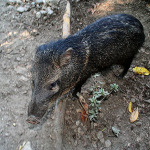 Peccaries – Vegetables and all Crops – At least as of this writing in late 2014, these animals haven’t been an issue for us even though there’s known to be a family of peccaries living nearby (also known as javelinas, which is a type of small intelligent wild pig.) If they find us, they will begin to raid our crops, uprooting and eating whatever they want. The normal solution for other farmers in the area would be to shoot and eat them, because they’re supposed to be very tasty, but that’s not an acceptable solution to us. We are hoping our large dog “Jedi” will chase them away if they ever come here.
Peccaries – Vegetables and all Crops – At least as of this writing in late 2014, these animals haven’t been an issue for us even though there’s known to be a family of peccaries living nearby (also known as javelinas, which is a type of small intelligent wild pig.) If they find us, they will begin to raid our crops, uprooting and eating whatever they want. The normal solution for other farmers in the area would be to shoot and eat them, because they’re supposed to be very tasty, but that’s not an acceptable solution to us. We are hoping our large dog “Jedi” will chase them away if they ever come here.
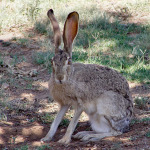 Rabbits – Veggies and Greens – Although rare, jackrabbits are native to Costa Rica and somehow survive here despite all the predators. Once they discover your food is a consistent sweet food source, they can multiply like crazy and wreak havoc. We suspect a rabbit ate our entire plantation of 287 sweet potato seedlings (or it may have been a deer.) I have no idea how to get rid of them if a big family gets established in your farm. I think you’d have to find a way to kill them or forget about trying to grow anything on the ground.
Rabbits – Veggies and Greens – Although rare, jackrabbits are native to Costa Rica and somehow survive here despite all the predators. Once they discover your food is a consistent sweet food source, they can multiply like crazy and wreak havoc. We suspect a rabbit ate our entire plantation of 287 sweet potato seedlings (or it may have been a deer.) I have no idea how to get rid of them if a big family gets established in your farm. I think you’d have to find a way to kill them or forget about trying to grow anything on the ground.
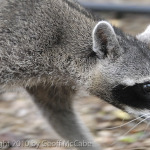 Raccoons – Chickens, Corn – These masked bandits are incredibly cute and a lot of fun when they’re babies if you happen to have one, but they grow up to be intelligent, vicious, potentially rabid furry monsters that will raid your farm. Besides killing your chickens and eating the eggs, they can kill and eat a house-cat. They even are adept at killing large dogs if they can lure it into water, in which case they will instinctively climb onto its head and drown it. If they discover your “milpa” (cornfield) they will come night after night, tearing down your cornstalks and eating your cobs. They only come at night and disturb your sleep with their many potential varieties of mischief. We are hoping our dog will be enough to keep them away and we will certainly chase them and throw stuff at them if we see them on the farm.
Raccoons – Chickens, Corn – These masked bandits are incredibly cute and a lot of fun when they’re babies if you happen to have one, but they grow up to be intelligent, vicious, potentially rabid furry monsters that will raid your farm. Besides killing your chickens and eating the eggs, they can kill and eat a house-cat. They even are adept at killing large dogs if they can lure it into water, in which case they will instinctively climb onto its head and drown it. If they discover your “milpa” (cornfield) they will come night after night, tearing down your cornstalks and eating your cobs. They only come at night and disturb your sleep with their many potential varieties of mischief. We are hoping our dog will be enough to keep them away and we will certainly chase them and throw stuff at them if we see them on the farm.
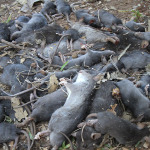 Rats and Mice – Corn, Peanuts, Chicken and Goat food, Sweet Potatoes, Worms – Rats climb up corn stalks to get the kernels and the top. They get into bags of food for your goats and chickens. They eat your worms in your worm beds. They dig down and gnaw on the top of your sweet potatoes. In short, they’re awful and a huge menace to a farmer. They live in dry places under piles of debris, old wood, etc, and we once killed (using sticks and bats) more than 70 of them in one nest (see photo on the right.) They’re almost impossible to eradicate. Live traps don’t work. Baited rat traps and glue traps are awful and don’t work well enough anyway. Another solution to rats is to find a “Rat Terrier” dog, which was at one point the most popular dog in the United States, with tens of millions of them, populating every small farm in the country. We were unable to find this breed in Costa Rica, but apparently they are natural rat killers and don’t even need to be trained. One solution that does work is a special grey box that has a very weak and slow-working poison in it. The boxes are attached to walls where the rats run, and they enter the boxes and eat the food. It takes weeks to kill them. Apparently the rat-nest king won’t eat any food that hasn’t been taste-tested for over a week by his workers first. So any strong, fast-acting poison will not kill the rat king. This solution can be provided by various exterminators in Costa rica. Putting any kind of poison in an organic farm is terrible, but this is the only solution to rats that we have found. The poison is very mild and contained inside the boxes.
Rats and Mice – Corn, Peanuts, Chicken and Goat food, Sweet Potatoes, Worms – Rats climb up corn stalks to get the kernels and the top. They get into bags of food for your goats and chickens. They eat your worms in your worm beds. They dig down and gnaw on the top of your sweet potatoes. In short, they’re awful and a huge menace to a farmer. They live in dry places under piles of debris, old wood, etc, and we once killed (using sticks and bats) more than 70 of them in one nest (see photo on the right.) They’re almost impossible to eradicate. Live traps don’t work. Baited rat traps and glue traps are awful and don’t work well enough anyway. Another solution to rats is to find a “Rat Terrier” dog, which was at one point the most popular dog in the United States, with tens of millions of them, populating every small farm in the country. We were unable to find this breed in Costa Rica, but apparently they are natural rat killers and don’t even need to be trained. One solution that does work is a special grey box that has a very weak and slow-working poison in it. The boxes are attached to walls where the rats run, and they enter the boxes and eat the food. It takes weeks to kill them. Apparently the rat-nest king won’t eat any food that hasn’t been taste-tested for over a week by his workers first. So any strong, fast-acting poison will not kill the rat king. This solution can be provided by various exterminators in Costa rica. Putting any kind of poison in an organic farm is terrible, but this is the only solution to rats that we have found. The poison is very mild and contained inside the boxes.
Conclusions
This is a difficult issue for those of us trying to live both in harmony with nature, and sustainably, since animals will inevitably come and attack your food and animals if you try to farm in a tropical jungle. The old-school method of shooting everything may work, but it’s not what most permaculture enthusiasts want, so we search for other solutions. This article contains details about all the animals that attack the farm, what they eat, and how we are trying to deal with them. Hopefully someone will find it helpful with their own farm adventures.
Like the rest of this website, this guide is a work in progress, and I hope to add new and improved information over the years. If you have any constructive feedback or creative ideas to help out, I’d love to hear your comments.













